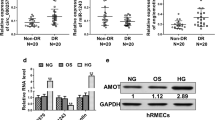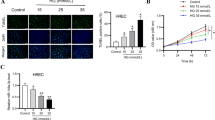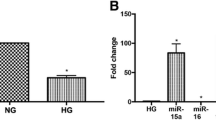Abstract
Diabetic retinopathy (DR) is one of the common microvascular complications of diabetes mellitus, which is the main cause of blindness in diabetic patients. Angiogenesis plays an important role in retinal detachment and retinal microvascular inflammation throughout the whole development of DR. This study aimed to investigate the regulatory effect and the potential mechanism of miR-377 on high glucose and hypoxia-induced angiogenesis and inflammation in human retinal endothelial cells, and found that the miR-377 level was significantly increased after high glucose and hypoxia-mimetic agent to simulate the DR milieu. Moreover, miR-377 was confirmed to directly decrease target SIRT1 gene, further aggravated proliferation, cell cycle transition, migration and angiogenesis, pro-inflammatory molecules release induced by high glucose and hypoxia in vitro. Conversely, down-regulation of miR-377 enhanced expression of SIRT1 and in turn alleviated high glucose and hypoxia-induced angiogenesis and inflammation in vitro. Additionally, Western blot results showed that down-regulation of miR-377 restrained high glucose and hypoxia-induced protein expressions of p-IκBα, nuclear P65 and p-P65. Conversely, up-regulation of miR-377 presented opposite results. Conclusively, down-regulation of miR-377 could partially suppress high glucose and hypoxia-induced angiogenic functions, restrain pro-inflammatory cytokines release, and its mechanism may though inhibition of NF-κB pathway by direct up-regulation of target gene SIRT1 expression. Our study suggests that miR-377 may be used as a potential novel target for prevention strategy for DR.








Similar content being viewed by others
Data Availability
All data are included in this published article. Any additional information related to this study is available from the author for correspondence upon reasonable request.
References
Chan JC, Zhang Y, Ning G. Diabetes in China: a societal solution for a personal challenge. Lancet Diabetes Endocrinol. 2014;2:969–79. https://doi.org/10.1016/S2213-8587(14)70144-5.
Muc R, Saracen A, Grabska-Liberek I. Associations of diabetic retinopathy with retinal neurodegeneration on the background of diabetes mellitus. Overview of recent medical studies with an assessment of the impact on healthcare systems. Open Med (Wars). 2018;13:130–6. https://doi.org/10.1515/med-2018-0008.
Dixon CJ, Knight T, Binns E, Ihaka B, O’Brien D. Clinical measures of balance in people with type two diabetes: a systematic literature review. Gait Posture. 2017;58:325–32. https://doi.org/10.1016/j.gaitpost.2017.08.022.
Uemura A. Pharmacologic management of diabetic retinopathy. J Biochem. 2018;163:3–9. https://doi.org/10.1093/jb/mvx057.
Marahrens L, Kern R, Ziemssen T, Fritsche A, Martus P, Ziemssen F, Roeck D. Patients’ preferences for involvement in the decision-making process for treating diabetic retinopathy. BMC Ophthalmol. 2017;17:139. https://doi.org/10.1186/s12886-017-0526-z.
Yang HS, Kim JG, Cha JB, Yun YI, Park JH, Woo JE. Quantitative analysis of neural tissues around the optic disc after panretinal photocoagulation in patients with diabetic retinopathy. PLoS One. 2017;12:e0186229. https://doi.org/10.1371/journal.pone.0186229.
Chen Q, Tan F, Wu Y, Zhuang X, Wu C, Zhou Y, Li Y, Cheng D, Wang J, Lu F, Shen M. Characteristics of retinal structural and microvascular alterations in early type 2 diabetic patients. Invest Ophthalmol Vis Sci. 2018;59:2110–8. https://doi.org/10.1167/iovs.17-23193.
Shao J, Yin Y, Yin X, Ji L, Xin Y, Zou J, Yao Y. Transthyretin exerts pro-apoptotic effects in human retinal microvascular endothelial cells through a GRP78-dependent pathway in diabetic retinopathy. Cell Physiol Biochem. 2017;43:788–800. https://doi.org/10.1159/000481562.
Xu J, Chen LJ, Yu J, Wang HJ, Zhang F, Liu Q, Wu J. Involvement of advanced glycation end products in the pathogenesis of diabetic retinopathy. Cell Physiol Biochem. 2018;48:705–17. https://doi.org/10.1159/000491897.
Sethi S, Sethi S, Bluth MH. Clinical implication of microRNAs in molecular pathology: an update for 2018. Clin Lab Med. 2018;38:237–51. https://doi.org/10.1016/j.cll.2018.02.003.
Kong P, Chen L, Yu M, Tao J, Liu J, Wang Y, Pan H, Zhou W, Wang S. miR-3178 inhibits cell proliferation and metastasis by targeting Notch1 in triple-negative breast cancer. Cell Death Dis. 2018;9:1059. https://doi.org/10.1038/s41419-018-1091-y.
Gao Y, Xiao F, Wang C, Wang C, Cui P, Zhang X, Chen X. Long noncoding RNA MALAT1 promotes osterix expression to regulate osteogenic differentiation by targeting miRNA-143 in human bone marrow-derived mesenchymal stem cells. J Cell Biochem. 2018;119:6986–96. https://doi.org/10.1002/jcb.26907.
Nallasamy P, Chava S, Verma SS, Mishra S, Gorantla S, Coulter DW, Byrareddy SN, Batra SK, Gupta SC, Challagundla KB. PD-L1, inflammation, non-coding RNAs, and neuroblastoma: Immuno-oncology perspective. Semin Cancer Biol. 2018;52:53–65. https://doi.org/10.1016/j.semcancer.2017.11.009.
Li P, Liu H, Li Y, Wang Y, Zhao L, Wang H. miR-339-5p inhibits lung adenocarcinoma invasion and migration by directly targeting BCL6. Oncol Lett. 2018;16:5785–90. https://doi.org/10.3892/ol.2018.9376.
Fu X, He Y, Wang X, Peng D, Chen X, Li X, Wan Q. MicroRNA-16 promotes ovarian granulosa cell proliferation and suppresses apoptosis through targeting PDCD4 in polycystic ovarian syndrome. Cell Physiol Biochem. 2018;48:670–82. https://doi.org/10.1159/000491894.
Zhao J, Gao S, Zhu Y, Shen X. Significant role of microRNA2195p in diabetic retinopathy and its mechanism of action. Mol Med Rep. 2018;18:385–90. https://doi.org/10.3892/mmr.2018.8988.
Yang C, Tahiri H, Cai C, Gu M, Gagnon C, Hardy P. microRNA-181a inhibits ocular neovascularization by interfering with vascular endothelial growth factor expression. Cardiovasc Ther. 2018;36:e12329. https://doi.org/10.1111/1755-5922.12329.
Qiu F, Tong H, Wang Y, Tao J, Wang H, Chen L. Inhibition of miR-21-5p suppresses high glucose-induced proliferation and angiogenesis of human retinal microvascular endothelial cells by the regulation of AKT and ERK pathways via maspin. Biosci Biotechnol Biochem. 2018;82:1366–1376. https://doi.org/10.1080/09168451.2018.1459179.
Chakrabarti S. MicroRNA15a-A molecule modulating multiple pathologies in diabetic retinopathy. EBioMedicine. 2016;11:13–4. https://doi.org/10.1016/j.ebiom.2016.08.017.
Li B, Xu WW, Han L, Chan KT, Tsao SW, Lee NPY, Law S, Xu LY, Li EM, Chan KW, Qin YR, Guan XY, He QY, Cheung ALM. MicroRNA-377 suppresses initiation and progression of esophageal cancer by inhibiting CD133 and VEGF. Oncogene. 2017;36:3986–4000. https://doi.org/10.1038/onc.2017.29.
Wang Q, Wang Y, Minto AW, Wang J, Shi Q, Li X, Quigg RJ. MicroRNA-377 is up-regulated and can lead to increased fibronectin production in diabetic nephropathy. FASEB J. 2008;22:4126–35. https://doi.org/10.1096/fj.08-112326.
Ma MM, Lin CX, Liu CZ, Gao M, Sun L, Tang YB, Zhou JG, Wang GL, Guan YY. Threonine532 phosphorylation in ClC-3 channels is required for angiotensin II-induced Cl(−) current and migration in cultured vascular smooth muscle cells. Br J Pharmacol. 2016;173:529–44. https://doi.org/10.1111/bph.13385.
Han J, Li Y, Liu X, Zhou T, Sun H, Edwards P, Gao H, Yu FS, Qiao X. Metformin suppresses retinal angiogenesis and inflammation in vitro and in vivo. PLoS One. 2018;13:e0193031. https://doi.org/10.1371/journal.pone.0193031.
Yu N, Zhu KJ, Ma SJ, Tang H, Tan XN. The total flavonoids of Clerodendrum bungei suppress A549 cells proliferation, migration, and invasion by impacting Wnt/β-catenin signaling. World J Tradit Chin Med. 2017;3:15–20. https://doi.org/10.4103/wjtcm.wjtcm_18_17.
Liang LN, Tang YZ, Zhan WJ, Li J, Ma QY, Liang J. LXHY formula inhibits choroidal neovascularization development via inhibiting the recruitment and adhesion of BMCs to the retina. World J Tradit Chin Med. 2018;4:62–8. https://doi.org/10.4103/wjtcm.wjtcm_8_18.
Keller-Pinter A, Szabo K, Kocsis T, Deak F, Ocsovszki I, Zvara A, Puskas L, Szilak L, Dux L. Syndecan-4 influences mammalian myoblast proliferation by modulating myostatin signalling and G1/S transition. FEBS Lett. 2018;592:3139–51. https://doi.org/10.1002/1873-3468.13227.
Yadav UC, Srivastava SK, Ramana KV. Prevention of VEGF-induced growth and tube formation in human retinal endothelial cells by aldose reductase inhibition. J Diabetes Complicat. 2012;26:369–77. https://doi.org/10.1016/j.jdiacomp.2012.04.017.
Feng S, Yu H, Yu Y, Geng Y, Li D, Yang C, Lv Q, Lu L, Liu T, Li G, Yuan L. Levels of inflammatory cytokines IL-1β, IL-6, IL-8, IL-17A, and TNF-α in aqueous humour of patients with diabetic retinopathy. J Diabetes Res. 2018;2018:8546423. https://doi.org/10.1155/2018/8546423.
Liu S, Bertl K, Sun H, Liu ZH, Andrukhov O, Rausch-Fan X. Effect of simvastatin on the osteogenetic behavior of alveolar osteoblasts and periodontal ligament cells. Hum Cell. 2012;25:29–35. https://doi.org/10.1007/s13577-011-0028-x.
Ge QL, Liu SH, Ai ZH, Tao MF, Ma L, Wen SY, Dai M, Liu F, Liu HS, Jiang RZ, Xue ZW, Jiang YH, Sun XH, Hu YM, Zhao YX, Chen X, Tao Y, Zhu XL, Ding WJ, Yang BQ, Liu DD, Zhang XR, Teng YC. RelB/NF-κB links cell cycle transition and apoptosis to endometrioid adenocarcinoma tumorigenesis. Cell Death Dis. 2016;7:e2402. https://doi.org/10.1038/cddis.2016.309.
Ji C, Guo H, Zhang P, Kuang W, Fan Y, Wu L. AnnexinA5 promote glioma cell invasion and migration via the PI3K/Akt/NF-κB signaling pathway. J Neurooncol. 2018;138:469–78. https://doi.org/10.1007/s11060-018-2818-4.
Xia ZB, Meng FR, Fang YX, Wu X, Zhang CW, Liu Y, Liu D, Li GQ, Feng FB, Qiu HY. Inhibition of NF-κB signaling pathway induces apoptosis and suppresses proliferation and angiogenesis of human fibroblast-like synovial cells in rheumatoid arthritis. Medicine (Baltimore). 2018;97:e10920. https://doi.org/10.1097/MD.0000000000010920.
Yuan L, Wu Y, Ren X, Liu Q, Wang J, Liu X. Isoorientin attenuates lipopolysaccharide-induced pro-inflammatory responses through down-regulation of ROS-related MAPK/NF-κB signaling pathway in BV-2 microglia. Mol Cell Biochem. 2014;386:153–65. https://doi.org/10.1007/s11010-013-1854-9.
Merrigan SL, Kennedy BN. Vitamin D receptor agonists regulate ocular developmental angiogenesis and modulate expression of dre-miR-21 and VEGF. Br J Pharmacol. 2017;174:2636–51. https://doi.org/10.1111/bph.13875.
Tiwari A, Mukherjee B, Dixit M. MicroRNA key to angiogenesis regulation: MiRNA biology and therapy. Curr Cancer Drug Targets. 2018;18:266–77. https://doi.org/10.2174/1568009617666170630142725.
Valle ML, Dworshak J, Sharma A, Ibrahim AS, Al-Shabrawey M, Sharma S. Inhibition of interleukin-6 trans-signaling prevents inflammation and endothelial barrier disruption in retinal endothelial cells. Exp Eye Res. 2018;178:27–36. https://doi.org/10.1016/j.exer.2018.09.009.
Kanda A, Ishida S. Receptor-associated prorenin system contributes to development of inflammation and angiogenesis in proliferative diabetic retinopathy. Inflamm Regen. 2016;36:22. https://doi.org/10.1186/s41232-016-0027-0.
Cai Y, Li W, Tu H, Chen N, Zhong Z, Yan P, Dong J. Curcumolide reduces diabetic retinal vascular leukostasis and leakage partly via inhibition of the p38MAPK/NF-κB signaling. Bioorg Med Chem Lett. 2017;27:1835–9. https://doi.org/10.1016/j.bmcl.2017.02.045.
Ott C, Jacobs K, Haucke E, Navarrete Santos A, Grune T, Simm A. Role of advanced glycation end products in cellular signaling. Redox Biol. 2014;2:411–29. https://doi.org/10.1016/j.redox.2013.12.016.
Chang YC, Lin CW, Hsieh MC, Wu HJ, Wu WS, Wu WC, Kao YH. High mobility group B1 up-regulates angiogenic and fibrogenic factors in human retinal pigment epithelial ARPE-19 cells. Cell Signal. 2017;40:248–57. https://doi.org/10.1016/j.cellsig.2017.09.019.
Funding
None.
Author information
Authors and Affiliations
Contributions
CC and YL carried out the study and the data statistics. CC participated in study design and drafted the manuscript. YL participated in study design and scientific discussion of the data.
Corresponding author
Ethics declarations
Conflict of interest
The authors have declared that no competing interests exist.
Additional information
Publisher’s Note
Springer Nature remains neutral with regard to jurisdictional claims in published maps and institutional affiliations.
Electronic supplementary material
Below is the link to the electronic supplementary material.
Rights and permissions
About this article
Cite this article
Cui, C., Li, Y. & Liu, Y. Down-regulation of miR-377 suppresses high glucose and hypoxia-induced angiogenesis and inflammation in human retinal endothelial cells by direct up-regulation of target gene SIRT1. Human Cell 32, 260–274 (2019). https://doi.org/10.1007/s13577-019-00240-w
Received:
Accepted:
Published:
Issue Date:
DOI: https://doi.org/10.1007/s13577-019-00240-w




